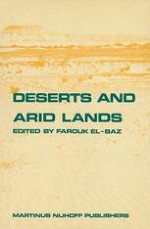
1984 | OriginalPaper | Chapter
The desert in the space age
Author : Farouk El-Baz
Published in: Deserts and arid lands
Publisher: Springer Netherlands
Included in: Professional Book Archive
Activate our intelligent search to find suitable subject content or patents.
Select sections of text to find matching patents with Artificial Intelligence. powered by
Select sections of text to find additional relevant content using AI-assisted search. powered by
The scarcity of basic information on the arid lands of the Earth has resulted in part from the difficulty and harshness of desert travel. Space photographs and images provide a new tool to study desert features and select areas for detailed field investigation. Color photographs obtained by the astronauts clearly depict variations, which are indicative of the chemical makeup of desert surfaces. Landsat images are useful in the study of temporal changes because of the repeated coverage of the same area at the same scale. Orbital photographs and images show the sand distribution patterns in desert areas and the effect on dune morphology of local topographic variations. Examples are given particularly from the Western Desert of Egypt, the driest part of the North African Sahara. Space age technology also allows the use of automated stations to gather meteorologic data in remote and inaccessible regions. Such advances help us to better understand the deserts of the Earth and better interpret similar terrains on the surface of Mars.